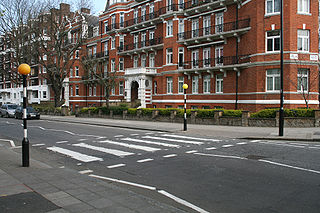 W
WThe fear of crossing streets, or its terms dromophobia and agyrophobia, is a specific phobia that affects a person's ability to cross a street or roadway where cars or vehicles may be present. The term dromophobia comes from the Greek dromos, meaning racetrack.
 W
WJade's Crossing is a footbridge in Detling, Kent, England. The footbridge crosses the A249, a major road which runs between Maidstone and Sheerness. The crossing is named after Jade Hobbs, who was killed attempting to cross the road in December 2000 aged eight. Her mother, Caroline, subsequently campaigned for the crossing to be built, and won a Special Award at the 2003 Pride of Britain Awards for her efforts.
 W
WJaywalking occurs when a pedestrian walks in or crosses a roadway that has traffic, other than at a suitable crossing point, or otherwise in disregard of traffic rules. The term originated with jay-drivers, people who drove horse-drawn carriages and automobiles on the wrong side of the road, before taking its current meaning.
 W
WA pedestrian crossing or crosswalk is a place designated for pedestrians to cross a road, street or avenue. The term "pedestrian crossing" is also used in some international treaties that pertain to road traffic and road signs, such as the Vienna Convention on Road Traffic and the Vienna Convention on Road Signs and Signals.
 W
WIn May 2013 the World Health Organization (WHO) reported that more than 270,000 pedestrians lose their lives on the world’s roads each year, accounting for 22% of the total 1.24 million road traffic deaths. Despite the magnitude of the problem, most attempts at reducing pedestrian deaths had historically focused solely on education and traffic regulation. Since the 1970s, crash engineers have begun to use design principles that have proved successful in protecting car occupants to develop vehicle design concepts that reduce the likelihood of injuries to pedestrians in the event of a car-pedestrian crash. These involve redesigning the bumper, hood (bonnet), and the windshield and pillar to be energy absorbing (softer) without compromising the structural integrity of the car. With the advent of ADAS since 2005, new pedestrian detection and crash avoidance and mitigation systems offer even greater improvements through active rather than passive protection systems. For example, omniview technology allows a driver to see what is a around the vehicle before moving.
 W
WA school bus crossing arm is a safety device intended to protect children from being struck while crossing in front of a school bus. Typically, school bus crossing arms are wire or plastic devices which extend from the front bumper on the right side of the bus when the door is open for loading/unloading and form a barrier. The devices force children, who need to cross the road, to stand several feet in front of the bus itself before they can begin to cross the road. This ensures that the bus driver can see them as they cross, avoiding a common blind spot immediately in front of the bus, closest to the bumper. The crossing arm retracts flush against the bumper while not activated, such as when the bus is in motion.
 W
WA walking bus is a form of student transport for schoolchildren who, chaperoned typically by two adults, walk to school along a set route, with some similarities to a school bus route. Like a real bus, walking buses have a fixed route with designated "bus stops" and "pick up times" at which they pick up and "drop off" children.